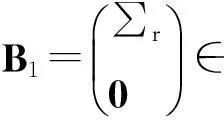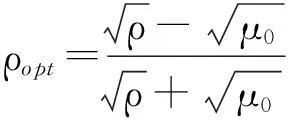奇异鞍点问题的一类迭代算法的半收敛性
周小燕
(浙江科技学院 理学院,杭州 310023)
奇异鞍点问题的一类迭代算法的半收敛性
周小燕
(浙江科技学院 理学院,杭州 310023)
摘要:提出了奇异鞍点问题的一类基于对矩阵的一种带2个实参数α和β的新的分裂的广义的SOR-like方法,得到了此方法半收敛的条件,以及最优参数与相应的最优半收敛因子。
关键词:鞍点问题;GSOR-like方法;半收敛;最优参数
考虑具有以下形式的鞍点问题:
(1)
式(1)中,A∈m×m为对称正定(SPD)矩阵;B∈m×n(这里假定m≥n);BT是B的转置矩阵;向量x,b∈m,y,q∈n,b,q是已知向量。
鞍点问题来自于非线性约束最优化(连续2次规划问题和内点法)、流体动力学(Stokes方程)、不可压缩弹性分析、电路分析及结构分析等。鞍点问题的求解与一般的线性方程组求解一样,有直接法和迭代法2种。直接法只进行有限步计算,所以,在不计入舍入误差的情况下,可以在有限步求得方程组的精确解,它比较适合阶数较低的线性方程组。迭代法是从解的一个初始估计值开始,逐步对它进行改进,直到达到所需的精度,理论上说,须经过无限次迭代才能收敛到真解;但实际上,只要用某种度量方式(如残量的范数),当度量的误差已小于某个给定值时,迭代即可终止。当系数矩阵是稀疏矩阵,且方程的阶数较大时,迭代法就比较适合,因为它运算量小,内存需求小。
当rank(B)=n,即B是列满秩矩阵,鞍点问题(1)(式(1))有唯一解。许多研究者对鞍点问题(1)进行了探讨,构造了大量有效的迭代算法,如Uzawa算法[1-3]、SOR-like法[4-7]、Krylov子空间法[8-9]、HSS迭代法[10-11]等。当rank(B)=r 当rank(B)=n,文献[7]构造了鞍点问题(1)的GSOR-like方法,讨论了此方法的收敛性、最优参数及相应的最小谱半径。本研究讨论当rank(B)=r 1基本概念和引理 用σ(A),ρ(A)分别表示矩阵A的谱集和谱半径。 定义1[20]设T∈n×n,当存在时,称T是半收敛的。 引理1[20]设T∈n×n,那么T半收敛当且仅当以下条件成立: 1)ρ(T)≤1; 2)如果ρ(T)=1,那么矩阵T的特征值1的所有初等因子是线性的,即rank(I-T)2=rank(I-T); 设A∈n×n,当M可逆时,称A=M-N为A的一个分裂。考虑线性方程组Ax=b,令T=M-1N,c=M-1b,则迭代 x(k+1)=Tx(k)+c (2) 有以下结果。 引理2[20]设A=M-N,其中M是可逆的,记T=M-1N,c=M-1b。那么对于任何初始向量x(0),迭代(式(2))半收敛于线性方程组Ax=b的一解x*当且仅当T是半收敛的,且 x*=(I-T)Dc+(I-E)x0,E=(I-T)(I-T)D, (3) 式(3)中,I是单位阵,(I-T)D是I-T的Drazin逆。 引理3[12]设H∈l1×l1,I∈l2×l2,l1,l2∈+,那么 (4) 半收敛当且仅当以下条件成立之一: 1)L=0,H是半收敛的; 2)ρ(H)<1。 2GSOR-like方法的半收敛性 方法1GSOR-like方法[7]: 设Q∈n×n是对称非奇异的,x(0)∈m,y(0)∈n是给定的初始向量,α,β,ω是实数,满足α>0,ω>0,α-ωβ≠0。对于k=0,1,2,…,计算 方法1等价于 (5) 式(5)中, (6) (7) 当rank(B)=n,鞍点问题(1)的系数矩阵是非奇异的,因此有唯一的解,文献[7]研究了收敛性质并确定了最优参数。当rank(B)=r 定理1设A∈m×m,Q∈n×n为SPD矩阵,B∈m×n,rank(B)=r GSOR-like方法收敛于奇异鞍点问题(1)的一解x*。 证明:由引理2,只需证明方法1的迭代矩阵M(ω,α,β)是半收敛的。 (8) (9) 定义矩阵: (10) 式(10)中,V1∈n×r,V2∈n×(n-r),那么 计算可得, (11) 式(11)中, (12) (13) 因为 (14) 所以,ρ同时也是Q-1BTA-1B的最大特征值。证毕。 3最优迭代参数 定理2设A∈m×m,Q∈n×n为SPD矩阵,分别是Q-1BTA-1B的最大和最小特征值,那么方法1的最优半收敛因子是 最优参数是 (15) 参考文献: [1]ELMANHC,GOLUBGH.InexactandpreconditionedUzawaalgorithmsforsaddlepointproblems[J].SiamJournalonNumericalAnalysis, 1994, 31(6):1645. [2]BRAMBLEJH,PASCIAKJE,VASSILEVAT.AnalysisoftheinexactUzawaalgorithmforsaddlepointproblems[J].SiamJournalonNumericalAnalysis, 1997, 34(3):1072. [3]BAIZZ,WANGZQ.OnparameterizedinexactUzawamethodsforgeneralizedsaddlepointproblems[J].LinearAlgebraanditsApplications,2008,428:2900. [4]GOLUBGH,WUX,YUANJY.SOR-likemethodsforaugmentedsystems[J].BitNumericalMathematics, 2001,41(1):71. [5]BAIZZ,PARLETTBN,WANGZQ.Ongeneralizedsuccessiveoverrelaxionmethodsforaugmentedlinearsystems[J].NumerischeMathematic, 2005,102(1):1. [6]HUANGZD,ZHOUXY.OntheminimumconvergencefactorofaclassofGSOR-likemethodsforaugmentedsystems[J].NumericalAlgorithms, 2015,70(1):113. [7]ZHOUXY.AgeneralizedSOR-likemethodforaugmentedsystems[J].JournalofZhejiangUniversityofScienceandTechnology,2015,27(6):459. [8]SAADY.IterativeMethodsforSparseLinearSystems[M]. 2nded.Philadelphia:SocietyforIndustrialandAppliedMathematics, 2003. [9]VANDERVORSHA.IterativeKrylovMethodsforLargeLinearSystems[M]∥Vol. 13ofCambridgeMonographsonAppliedandComputationalMathematics.NewYork:CambridgeUniversityPress,2003. [10]BENZIM,GOLUBGH.Apreconditionerforgeneralizedsaddlepointproblems[J].SIAMJournalonMatrixAnalysisandApplications,2004, 26(1):20. [11]BAIZZ,GOLUBGH.AcceleratedHermitianandskew-Hermitiansplittingiterationmethodsforsaddle-pointproblems[J].ImaJournalofNumericalAnalysis, 2007, 27(1):1. [12]ZHENGB,BAIZZ,YANGX.Onsemi-convergenceofparameterizedUzawamethodsforsingularsaddlepointproblems[J].LinearAlgebraandItsApplications, 2009,431:808. [13]ZHANGGF,WANGSS.AgeneralizationofparameterizedinexactUzawamethodforsingularsaddlepointproblems[J].AppliedMathematicsandComputation, 2013, 219(9):4225. [14]CHAOZ,CHENG.Anoteonsemi-convergenceofgeneralizedparameterizedinexactUzawamethodforsingularsaddlepointproblems[J].NumericalAlgorithms, 2014, 68(1):95. [15]ZHANGN,LUTT,WEIY.Semi-convergenceanalysisofUzawamethodsforsingularsaddlepointproblems[J].JournalofComputationalandAppliedMathematics, 2014, 255(285):334. [16]LIANGZZ,ZHANGGF.Semi-convergenceanalysisoftheGPIUmethodforsingularnonsymmetricsaddle-pointproblems[J].NumericalAlgorithms, 2014, 70(1):151. [17]BAIZZ.Onsemi-convergenceofHermitianandskew-Hermitiansplittingmethodsforsingularlinearsystems[J].Computing, 2010, 89:171. [18]CHAOZ,ZHANGN.AgeneralizedpreconditionedHSSmethodforsingularsaddlepointproblems[J].NumericalAlgorithms, 2014, 66(2):203. [19]WANGSS,ZHANGGF.PreconditionedAHSSiterationmethodforsingularsaddlepointproblems[J].NumericalAlgorithms, 2013, 63(3):521. [20]BERMANA,PLEMMONSRJ.NonnegativeMatricesintheMathematicalSciences[M].Philadelphia:SocietyforIndustrialandAppliedMathematics,1994. doi:10.3969/j.issn.1671-8798.2016.03.001 收稿日期:2016-04-10 作者简介:周小燕(1976—),女,浙江省萧山人,副教授,硕士,主要从事计算数学研究。 中图分类号:O241.6 文献标志码:A 文章编号:1671-8798(2016)03-0177-05 On semi-convergence of a generalized SOR-like method for singular augmented systems ZHOU Xiaoyan (School of Sciences, Zhejiang University of Science and Technology, Hangzhou 310023, China) Abstract:A generalized SOR-like method for singular augmented systems based on a new splitting of the iterative matrix with two real parameters α and β is presented. The semi-convergence conditions and the optimal iteration parameters and the corresponding optimal semi-convergence factor of this method are derived. Keywords:augmented systems; GSOR-like methods; semi-convergence; the optimal parameters






















